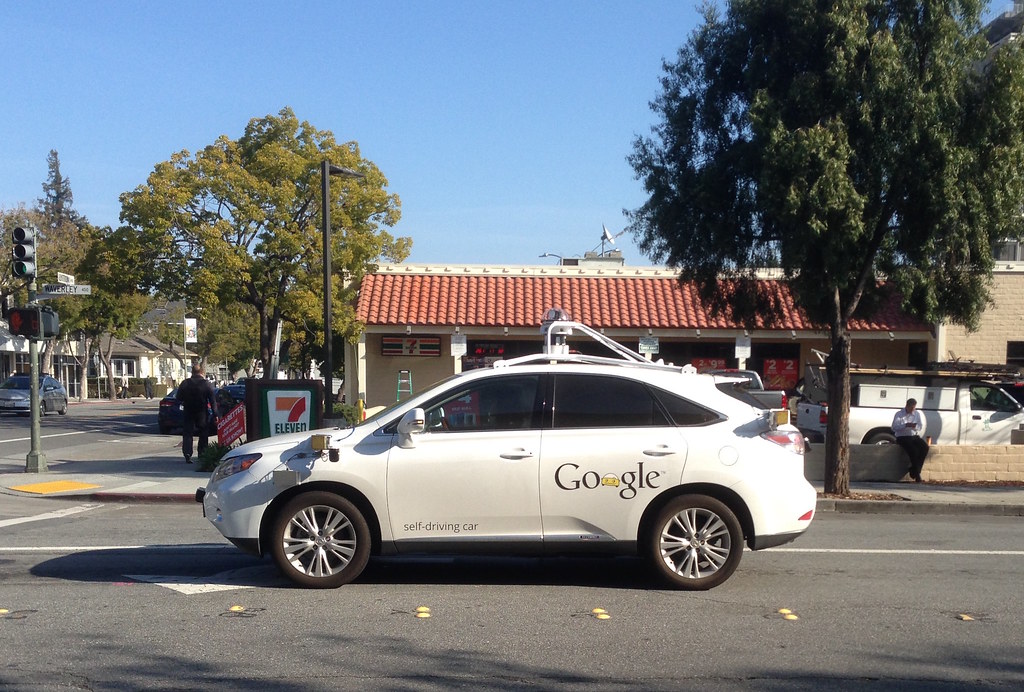Dear T4America members,
USDOT is now seeking applications for a ninth round of TIGER grants. USDOT will be awarding a total of $500 million on a competitive basis to transportation projects that “will have a significant impact on the Nation, a metropolitan area, or a region.” While T4America fights for the continued existence of the TIGER program in 2018 and beyond, we wanted to share four quick things about this ninth round of TIGER grants as you consider applying:
1) There’s no need to rethink your existing projects or recast them for the new administration. It may be a surprise, but USDOT is using the same criteria for this round that they were using under President Obama in 2016. If you have a project you think is competitive or have submitted for recent rounds, don’t recast the project or rework the application expecting the criteria to be drastically different.
The one change was an inclusion of a rural focus, but even that emphasizes the typical goals of TIGER: “improved access to reliable, safe, and affordable transportation for communities in rural areas, such as projects that improve infrastructure condition, address public health and safety, promote regional connectivity, or facilitate economic growth or competitiveness.” And though unspoken in this notice of funding, USDOT and the Trump administration have put a big emphasis on public-private partnerships, which surely would be welcomed in the TIGER program as well.
2) Get your applications in quick. Another reason to avoid trying to recast a project or come up with a brand new project is that applications are due very soon. Unlike past rounds with as much as three months to prepare applications, there’s just a little over a month to submit your applications for consideration by October 16th. Therefore, you should choose a project that has a firm scope, budget and partners in order to get those applications in by the deadline.
3) Broad support will be vital. While the criteria may not have changed, the administration is likely to respond better to projects that have the broadest support from other local, state and federal elected leaders as well as business and civic leaders from you area. If you don’t have your congressional delegation on board, set up meetings as soon as possible to garner their support. Ask them to write supportive letters to USDOT and include your project as a topic of conversation at meetings with USDOT and other administration representatives. Having a broad bench of support from all levels of government for their project can have a positive impact on your project’s likelihood of winning an award. Why should USDOT select a project that’s not even supported by all the stakeholders?
4) Don’t forget, members can tap our expertise. As a benefit of membership, you can get free advice and staff time from T4America to answer questions about your application and help you submit the strongest application possible. Please don’t hesitate to get in touch with us, which you can do through outreach director Ranata Reeder: ranata.reeder@t4america.org
We wish you all the best of luck. And we hope to have good news about preserving funding for TIGER in 2018, though we’ll be counting on your continued support and advocacy to buttress those efforts in Congress over the next month or two.
Beth Osborne
Interim Director
Recent Congressional Activity Summary-Week of September 8th
As a valued member, Transportation for America is dedicated to providing you the latest information and developments around federal policy. This dedication includes in-depth summaries of what is going on in Congress and the U.S. Department of Transportation (U.S. DOT). Check out what you may have missed in our member webinar last week.
House of Representatives Appropriations
Before this Friday, current appropriations for the Federal Government were scheduled to expire September 30th, which is the end of the 2017 fiscal year.
During this past week, the House of Representatives (House) considered H.R. 3354, a mini-omnibus package consisting of 8 appropriations bills, including the Transportation, Housing and Urban Development (THUD) appropriations bill. The official title of the omnibus package is the “Make America Secure and Prosperous Appropriations Act, 2018.”
The four appropriations bills the House considered on Wednesday were 1) Agriculture/Rural Development 2) THUD, 3) Homeland Security and 4) State/Foreign Operations. On Thursday and Friday, the House began consideration of the four remaining appropriations bills which are 5) Interior/Environment, 6) Commerce, Justice, Science, 7) Financial Services and 8) Labor/Health and Human Services.
While a final House vote on the House appropriations package was initially scheduled for Friday, the impending arrival of Hurricane Irma caused the House to delay final consideration and passage of the “Make America Secure and Prosperous Appropriations Act, 2018” until this upcoming week. This decision was made in order to give the representatives from Florida, and other states likely to be impacted by Irma, time to get home to their constituents.
After the passage of these 8 bills, the House will have passed all 12 of their appropriations bills that fund the activities of the Federal Government. The House passed their first four appropriations bills before August recess; those bills fund the Defense Department, the Department of Veteran Affairs, Legislative Operations, and Energy and Water.
The House Rules Committee, which is the body of the House that determines the rules for debate on a given bill, advanced for floor consideration roughly 40 amendments out of the 90 amendments that were submitted to the Rules Committee for consideration on the House THUD bill. You can access T4America’s tracker of the amendments T4America was watching closely here.
There were two amendments that were made in order that T4America was concerned about. Those two amendments were the Ted Budd amendment (Republican, North Carolina’s 13th Congressional District) and the Mo Brooks amendment (Republican, Alabama’s 5th Congressional District). Representative Budd’s amendment would have: 1) cut $475 million from the Federal-State Partnership for State of Good Repair grants, which was funding intended in part for the Amtrak gateway project, 2) eliminated the possibility of restoring funding for the TIGER program by applying the savings to deficit reduction and 3) Shifted $400 million in funding from intercity city passenger rail grants to the New Starts Program. Representative Brooks’ amendment would have eliminated federal funding for Amtrak’s national network operations.
Thankfully, the Budd amendment failed to pass by a vote of 159-260 and the Brooks amendment failed to pass by a vote of 128-293.
Debt Ceiling and Continuing Resolution Agreement
On Wednesday, during a meeting with Congressional leaders from both parties, President Trump reached an agreement with Senate Minority Leader Chuck Schumer and House Minority leader Nancy Pelosi to extend the debt ceiling and government funding by approximately three months until December 8th, as part of a legislative package that provides federal funding for Hurricane Harvey relief and extends the federal flood insurance program temporarily. The Senate passed this legislative package on Thursday by a vote of 80-17 and the House of Representatives passed it on Friday by a vote of 316-90, sending the legislation to President Trump, which he signed into law on Friday.
Surprisingly, a majority of Republicans in both Houses voted to pass the package even though Speaker Paul Ryan and Majority Leader Mitch McConnell indicated they strongly disagreed with the deal President Trump struck with Democrats and the influential House Republican Study Committee and other outside conservative groups opposed the deal as well.
Due to the passage of the legislative package, the debt ceiling and appropriations for the Federal government will now end on December 8th. We expect this deadline to lead to intense, high-stakes negotiations to reach a full year appropriations agreement and a long-term extension of the debt ceiling. Additionally, because of the importance of these negotiations, we expect immense pressure to include other items that are unrelated to appropriations but important to one party or the other. For example, early indications are that Democrats will insist on no discretionary funding spending cuts, the inclusion of the Deferred Action for Childhood Arrivals (DACA) program and health care insurer payments to stabilize ACA as the price for their votes.
Senate Appropriations
The Senate Appropriations Committee is still in the process of writing and approving their Appropriations bills. So far, the process in the Senate has been bipartisan and they have rejected cuts to non-defense discretionary spending that the House has adopted in their appropriations bills. Due to the spending cuts, the process in the House has been more partisan than the Senate.
There has been no indication from Senate Majority Leader Mitch McConnell that there will be Senate floor time to consider individual appropriations bill. At this point, T4America expects that all 12 of the appropriations bills will be rolled up into a giant omnibus by the new deadline of December 8th after negotiations over top line funding levels are completed with the House and between the two parties.
House and Senate Automated Vehicle Legislation
The House of Representatives on Wednesday passed by voice vote their bipartisan automated vehicle legislation, H.R. 3388, the Safely Ensuring Lives Future Deployment and Research In Vehicle Evolution Act” or the “SELF DRIVE Act. Members can see our statement about the bill here. The House Energy and Commerce’s subcommittee on Digital Commerce and Consumer Protection (DCCP) has been examining the issue since late 2016 and actively considering legislation since June.
The legislation that passed the House this past Wednesday was led by DCCP subcommittee Chairman Robert Latta (Republican, Ohio 5th Congressional District) and ranking member Jan Schakowsky (Democrat, Illinois 9th Congressional District). The legislation does a number of things including: 1) delineating the federal and state/local roles when it comes to regulating automated vehicles via a pre-emption clause, 2) establishing a specific exemption from federal motor vehicle safety standards to test automated vehicles, 3) raising the number of safety exemptions a manufacturer can get to test vehicles to 100,000 over three years and 4) establishing an automated vehicle advisory committee to advise the Secretary of U.S. DOT on a number of issues related to automated vehicles.
On Friday, the Senate Commerce Committee released a draft of their automated vehicle legislation. Senate Commerce Committee Chairman John Thune (Republican, South Dakota) and Senator Gary Peters (Democrat, Michigan) have been leading the legislative efforts in the Senate. The Smart Cities team is currently analyzing the Senate bill and will continue to work with Senators to make improvements to the House AV bill.
TIGER Notice of Funding Opportunity (NOFO)
On Thursday, U.S. DOT released the FY 2017 notice of funding opportunity (NOFO) for the $500 million TIGER program. U.S. DOT will evaluate projects based on the extent to which they benefit safety, economic competitiveness, state of repair, quality of life and environmental sustainability. These are the same selection criteria used in the TIGER rounds from 2014, 2015 and 2016. However, this Administration will emphasize “improved access to reliable, safe, and affordable transportation for communities in rural areas, such as projects that improve infrastructure condition, address public health and safety, promote regional connectivity, or facilitate economic growth or competitiveness.”
Applications are due by 8:00 p.m. E.D.T. on October 16, 2017 and U.S. DOT is hosting informational webinars on Wednesday September 13th, Tuesday September 18th, and Wednesday September 19th.
President Trump Nominations to U.S. DOT Agencies
On Friday, President Trump announced his intent to nominate Mr. Howard R. Elliot to be administrator of the Pipeline and Hazardous Materials Safety Administration (PHMSA) and Mr. Paul Trombino III to be the administrator of the Federal Highways Administration (FHWA). Mr. Elliot most recently served as the Vice President of Public Safety, Health, Environment and Security for Class 1 Railroad CSX Transportation. Mr Trombino is the former director of the Iowa Department of Transportation from 2011 to 2016 under Iowa Governor Terry Branstad and the former President of the American Association of State Highway Transportation Officials (AASHTO). The U.S. Senate must confirm both nominees.
With these nominees, President Trump has nominated someone to head FHWA, PHMSA, the Federal Railroad Administration (FRA) and the Maritime Administration (MARAD) while the Federal Transit Administration (FTA) and the National Highway Traffic Safety Administration (NHTSA) still await nominees to lead them.
Stories You May Have Missed – Week of September 8th
Stories You May Have Missed
As a valued member, Transportation for America is dedicated to providing you pertinent information. This includes news articles to inform your work. Check out a list of stories you may have missed last week.
- The House of Representatives on Friday cleared a short-term measure to avoid a government shutdown and raise the debt limit through December 8th, ratifying a deal President Trump struck with Democrats. (The Hill)
- Earlier in the week, President Trump reached a deal with Senator Minority Leader Chuck Schumer and House Democratic Leader Nancy Pelosi to provide Hurricane Harvey relief and raise the debt ceiling and extend government funding until December 8th. (Politico)
- The House of Representatives began consideration of a package of 8 appropriations bills this week, including the Transportation and Housing and Urban Development (THUD) appropriations bill. (See T4America’s blog post and amendment tracker here)
- The House of Representatives rejected a proposed amendment to the THUD appropriations bill that would have defunded Amtrak. (The Hill)
- Because of Hurricane Irma, the House delayed final passage of the appropriations package until the week of September 11th. (Politico)
- House Republicans still lack the votes to pass their draft House budget, putting at risk their efforts to pass tax reform. (The Hill)
El Paso’s Transnational Trolley: How art can help imagine creative transportation solutions
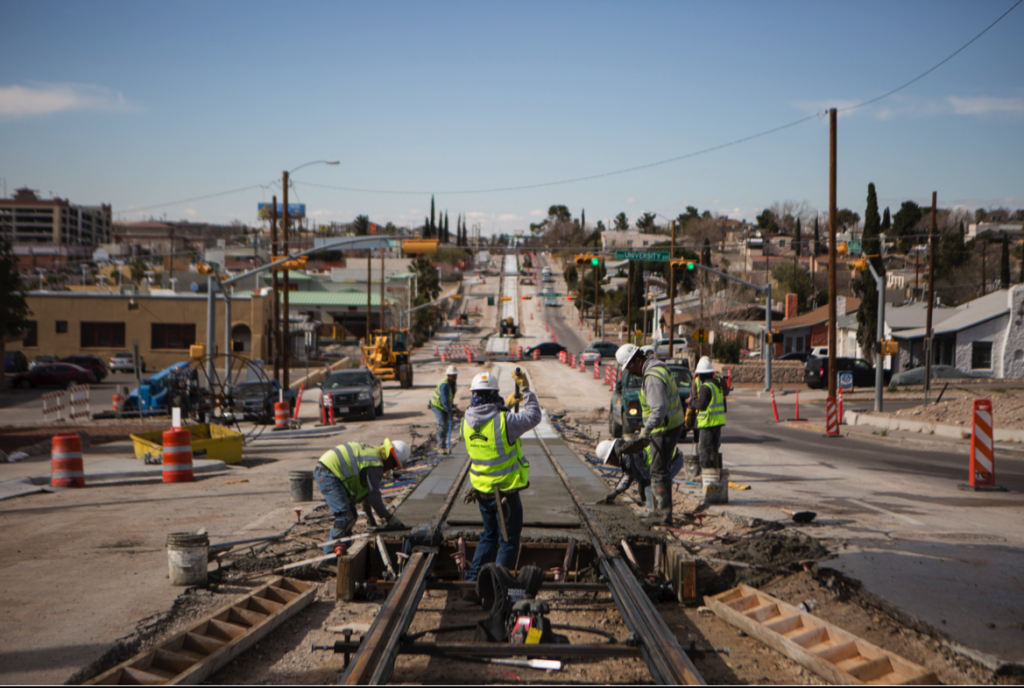
What begun as a sort of arts-driven guerilla marketing campaign for the fictional return of a historic streetcar in the border communities of El Paso, TX and Ciudad Juárez, Mexico, is becoming a reality, a demonstration of the power of art to capture the imagination of a community and help them look at old problems in different ways and imagine creative solutions.

This story is part of arts and culture month at T4America & Smart Growth America, where we’re telling a handful of stories about how arts and culture are essential to building better transportation projects and stronger communities. It’s adapted from a longer case study that will be featured in Transportation for America and ArtPlace America’s upcoming field scan on arts, culture and transportation.
Unlike San Diego, CA and Tijuana, Mexico, which are separated by 20 miles, El Paso, TX and Ciudad Juárez, Mexico sit immediately adjacent to one another, separated only by the width of the Rio Grande River and the international border between the United States and Mexico. Until 1846, El Paso was in fact part of Juárez and Mexico, and the two independent cities today form the world’s largest binational metroplex, with thousands of daily crossings by foot, car, and bus; billions of dollars of trade; and five border crossings connecting the two cities and region. For generations, residents on both sides of the border have crossed frequently for work, school, recreation, and to visit family; more than 80 percent of El Pasoans identify as Latinx.
Until it was closed down in 1974, these border crossings were facilitated in part by an international streetcar system that connected the downtowns of both cities. As in many American cities, the streetcar system ran President’s Conference Committee (PCC) streetcars, with a sleek Art Deco design that was introduced after the Great Depression to lure new car owners back onto public transportation.


The iconic streetcars and stories of their transnational past served as the inspiration for Peter Svarzbein’s Masters of Fine Arts thesis project at New York’s School for Visual Arts. In 2012 Mr. Svarzbein, a native of El Paso, created the El Paso Transnational Trolley, which could be described as part performance art, part guerrilla marketing, part visual art installation, and part fake advertising campaign. The project began with a series of wheatpaste posters advertising the return of the El Paso-Juárez streetcar, and continued with the deployment of Alex the Trolley Conductor, a new mascot and spokesperson for the alleged new service. Alex appeared at Comic Cons, public parks, conferences, and other public spaces to promote the return of the streetcar, while additional advertisements appeared across El Paso, sparking curiosity and excitement for the assumed real project.


Eventually, Svarzbein admitted that the project was a graduate thesis masquerading as a streetcar launch, but rather than graduating and moving on, he decided to move back home to El Paso.
When Svarzbein learned that the City of El Paso planned to sell the historic PCC streetcars, he lobbied the city to cancel the sale, and instead return the streetcars to the streets of El Paso. Thanks to the region’s dry climate, the streetcars have remained in relatively good shape for the past four decades even though they’ve been stored in the open desert at the edge of El Paso.


After gathering thousands of signatures in support of the project and with the strong backing of the City of El Paso and Texas Department of Transportation (TxDOT) Commissioner Ted Haughton, the El Paso trolley won a $97 million grant from TxDOT. It is now slated to begin service in El Paso in 2018. The third phase of the project will include a connection to the Medical Center of the Americas, while the second will include the much anticipated transnational connection to Juárez.


In one of the most surprising twists in this long tale, shortly after this funding was awarded, Svarzbein rode the wave of public support for the once-fictional project to win a seat on El Paso’s City Council.
Svarzbein’s approach as an artist transformed the discussion. The project’s website quotes artist Guillermo Goméz-Peña: “An artist thinks differently, imagines a better world, and tries to render it in surprising ways. And this becomes a way for his/her audiences to experience the possibilities of freedom that they can’t find in reality.”
Clearly, Svarzbein credits his creative campaign with helping to get the project off the ground and building the community support needed to win funding, claiming that “there is a sort of responsibility that artists have to imagine and speak about a future that may not be able to be voiced by a large amount of people in the present. I felt that sort of responsibility. If I couldn’t change the debate, at least I could sort of write a love letter to the place that raised me.”
This story is another example of how transportation professionals are exploring new, creative, and contextually-specific approaches to planning and building transportation projects. They are collaborating with artists and the community in new ways to transform transportation systems into powerful tools to help people access opportunity, drive economic development, improve health and safety, and build the civic and social capital that binds communities together.
This project is just one of the many case studies that will be featured in our upcoming field scan on arts, culture and transportation, commissioned by ArtPlace America. The field scan is intended to examine the ways in which arts and culture are helping to solve transportation challenges while engaging the community in a more inclusive process.
Stay tuned for more about arts and culture during the entire month of September.
Celebrating a month of arts and culture in transportation

Throughout the rest of September, along with our parent organization Smart Growth America, we’ll be celebrating the positive, measurable impacts that arts and culture can have on transportation projects by sharing a handful of inspiring local stories, culminating with the release of a new examination of creative placemaking we produced with ArtPlace America at the end of this month.

Why spend the better part of a month talking about arts and culture? And what does it have to do with building better transportation projects?
Every great place — whether small town, big city, local neighborhood — also has a unique sense of itself that’s reflected in or supported by the arts and local culture. Because the arts are a core part of strengthening the social, physical, and economic fabric of communities, they’re also a key part of smart growth, which is all about building great, sustainable, lovable places.
We’re going to spend the rest of this month sharing a handful of stories about how arts and culture are essential to building better transportation projects that do more to lift up and celebrate what’s unique about the local communities where they are located.
Hopefully you’ve already pored over The Scenic Route, T4America’s primer to creative placemaking in transportation. But we’ve got more coming: ArtPlace America selected T4America to partner with them to undertake a rigorous national examination of creative placemaking to better understand how and where artists, designers, and cultural workers are collaborating with local governments and community partners to solve transportation challenges.
As we get prepare to release this “field scan” later in September with ArtPlace America, we are going to share a handful of stories that bring this issue to life; stories that show how arts and culture are not a “nice to have” when it comes to transportation or local community development projects — they’re essential.
Tune in throughout the rest of September as we share stories each week on our blog and on social media. Here are the stories that we’ve shared so far:
El Paso’s Transnational Trolley: How art can help imagine creative transportation solutions
September 8, 2017
What began as a sort of arts-driven guerilla marketing campaign for the fictional return of a historic streetcar in the border communities of El Paso, TX and Ciudad Juárez, Mexico, is becoming a reality, a demonstration of the power of art to capture the imagination of a community and help them look at old problems in different ways and imagine creative solutions. Read more >>

Engaging east Portland to plan a more inclusive bus rapid transit line
September 12, 2017
When roughly 14 miles of a bus rapid transit line was proposed along Division Street in East Portland, the effort was greeted with interest in an often-neglected area of the city, but also concern about the possibilities of displacement and development poorly engaged with the unique local culture. To address those concerns, community members throughout the Jade and Division Midway districts were engaged through arts and culture projects to recalibrate the plan to better serve community needs. Read more >>
House abdicates methodical policymaking for new regulations on automated vehicles
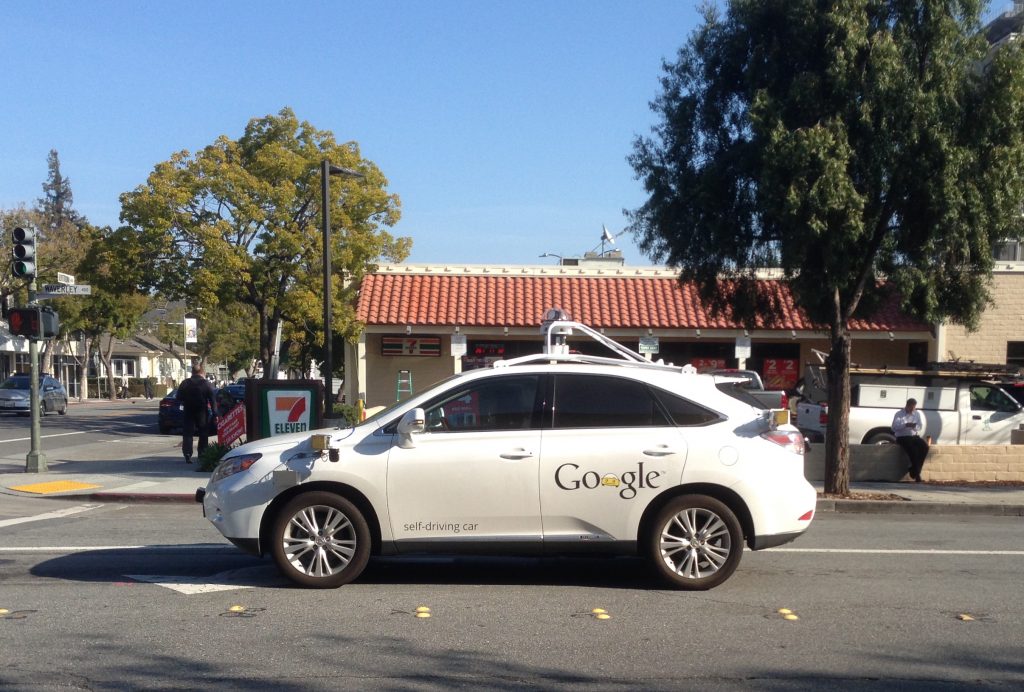
Congress has taken the first major legislative step to encourage & govern the roll-out of automated vehicles, passing the SELF DRIVE Act of 2017 by a voice vote today. Unfortunately, the House only consulted a narrow range of stakeholders like automakers and technology companies to produce this flawed legislation.
House policymakers were eager to move quickly after facing heavy pressure from private sector groups like automakers, mobility providers (such as Uber or Lyft), and tech industry groups that are working on self-driving technology.
“This bill was produced quickly and voted upon in committee within hours of replacing the entire bill text with an amendment,” said T4America interim director Beth Osborne. “As a result, the unanimous subcommittee and committee votes are less about bipartisan agreement and more the product of a lack of interest in thoughtfully producing sound policy on a critical issue with the potential to reshape our towns, suburbs, and cities dramatically.”
“Without bringing mayors, city or state transportation officials, law enforcement, and others to the table, the House hastily legislated on an issue about which they’re poorly informed, with impacts that will be felt for decades primarily by people and groups who were never invited into the room,” Osborne said.
Cities aren’t opposed to producing legislation to govern how automated vehicles (AVs) operate on our streets — far from it.
But many are concerned by this rush to legislate without their input. They’re convinced of the long-term benefits that self-driving technologies could offer, but want a legislative framework that allows them to experiment, innovate and bring these new technologies to the market in their cities in flexible ways that help them meet other goals.
While no one wants to see a patchwork of regulations that stifle innovation, one of our primary concerns — and that of many of the cities — is that this legislation will preempt local authorities from managing their own streets and fail to give local leaders the confidence that manufacturers and operators will be aware of and follow local laws and regulations.
As written, depending on how certain terms are interpreted, any state and local laws could be at risk if they are found to be an “unreasonable restriction.” This vague language will almost certainly lead to costly legal battles to determine what that term even means when the rubber meets the road.
AVs absolutely need to be tested in real-world situations. But they also need to be tested in manner that ensures public safety and builds public confidence in the technology. Allowing huge levels of safety exemptions per manufacturer each year, increasing from the current level of 2,500, to 25,000 in the first year, up to 100,000 in just three years, is too much too fast. Especially considering that this technology is still very much in its infancy and these vehicles are likely to be clustered in urban centers and not evenly distributed.
What if three manufacturers all want to test the bulk of their vehicles in one or two cities? Shouldn’t federal safety watchdogs like the National Highway Traffic Safety Administration (NHTSA) have some role to play in assessing their safety along the way and deciding whether or not exemptions should increase based on actual results from testing?
When it comes to safety, cities (and others) also need access to the data on how these vehicles are performing on their own streets. While the bill does require manufacturers testing AVs to report all crashes to NHTSA, it doesn’t require data-sharing on disengagements, near misses or other vehicle movement, safety, and performance indicators. There are also no requirements to share any data with cities, states, academics or relevant parties such as safety advocates for independent review and wouldn’t be subject to the Freedom of Information Act (FOIA) either.
This legislation ensures that no one other than the private companies doing the testing will be able to learn anything from the massive amounts of data produced by the tests. In order to create more hospitable conditions for all modes of travel, especially AVs, cities and states need these data to inform and optimize their planning, policymaking and operations to prepare for the coming wave of automation.
It’s important that Congress take this issue more seriously and bring all the stakeholders together to produce thoughtful legislation that balances the needs of private industry with the public’s desire for safety, transparency, and improved mobility.
The next step will be a Senate version of the bill and we’re eager to work with them and bring cities to the table to produce something stronger than the House’s first attempt.
House making final decisions on cuts to TIGER, transit construction & rail this week
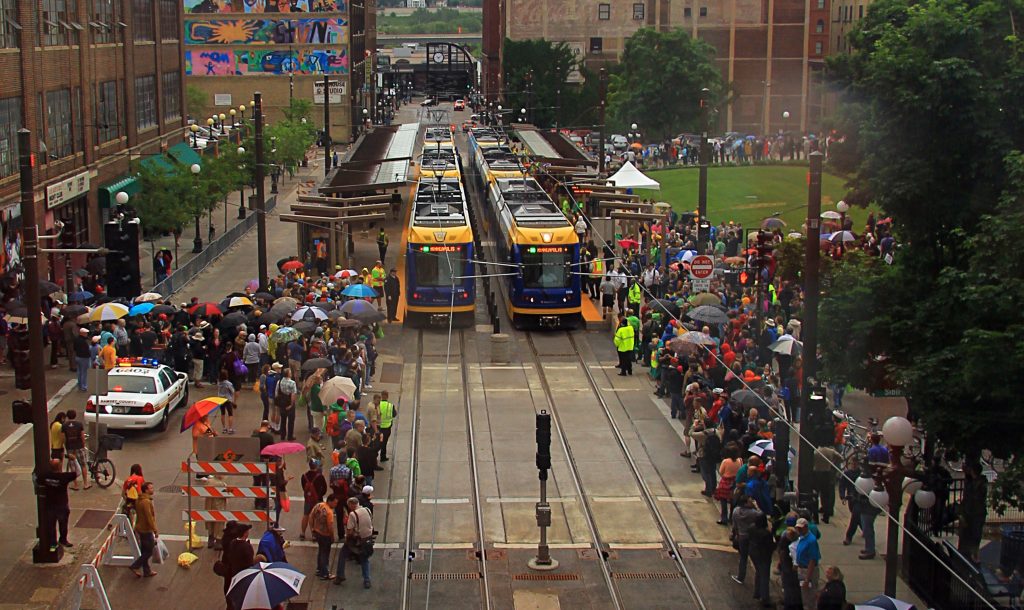
With the current federal transportation budget expiring at the end of this month, this week the House is considering a handful of amendments and taking a final vote on the 2018 fiscal year budget. Up for debate are amendments that could improve — or further damage — the House’s already problematic transportation budget for 2018.
With the September 30th deadline rapidly approaching, appropriations committees in both the House and Senate have been debating and setting funding levels for transportation programs for next year, including the discretionary programs that the Trump administration has targeted for cuts (i.e., those not funded by the Highway Trust Fund.)
While the Senate largely rejected the Trump administration’s request for cuts to programs like TIGER, new transit construction, and passenger rail programs (read our detailed breakdown of the current House/Senate bills here), the House’s version of the 2018 budget eliminated TIGER funding and reduced the transit capital program down near levels that would only fund transit projects that already have signed funding agreements in hand.
This week the House is scheduled to consider their final House Transportation, Housing and Urban Development (THUD) appropriations bill, and there are crucial amendments that could improve the bill by restoring funding for some of these programs — or make the damage far worse.
We’re asking T4America supporters to take action and send a message to their representatives this week urging them to protect and preserve the TIGER competitive grant program, funding for new transit construction, and passenger rail programs that keep towns and cities of all sizes connected to one another. It’s important that the House pass a bill with robust funding for these programs to set their starting point for negotiations with the Senate on the final product.
TAKE ACTION
Read about the amendments that we’ll be watching closely in the tracker below. Feel free to include information on these amendments as you send emails or make phone calls to your reps, and follow along on Twitter @t4america for updates as the debate begins this week. (Some of these amendments may be rejected by the House Rules Committee before they reach the floor — they are expected to only allow a few amendments for full floor consideration.)
Logged-in T4America members can read our detailed summary of the House THUD appropriations bill and vote below.
[member_content]Members can read T4America’s full members-only memo here.[/member_content]
| Number | Sponsor | Description | Outcome |
|---|---|---|---|
| 7 | Maxine Waters (D-CA) | Provides $7.5 billion for the TIGER program. | Ruled out of order |
| 8 | Maxine Waters (D-CA) | Provides $550 million for the TIGER program, includes the current TIGER project eligibility criteria, specifically requires the Secretary to award the funds using the 2016 NOFO criteria, and requires that the Secretary distributes the grants 225 days after the enactment of the bill. | Ruled out of order |
| 13 | Rosa DeLauro (D-CT) | Provides $500 million for the TIGER program. | Ruled out of order |
| 66 | Rod Blum (R-IA) | Provides $200 million for the TIGER program and reduces HUD tenant rental assistance by $200 million as an offset. | Ruled out of order |
| 46 | Mark Amodei (R-NV) | Requires the Secretary of Transportation to continue administering the current transit Capital Investment Grant Program and enter into a grant agreement with any Small Starts project that has satisfied the current eligibility requirements. | Ruled out of order |
| 38 | Darren Soto (D-FL) | Increases the amount of funding for Small Starts funding by $48 million and decreases funding for intercity passenger rail projects by the same amount as an offset. | Withdrawn |
| 48 | Mo Brooks (R-AL) | Eliminates funding for Amtrak's National Network only. | Failed by a vote of 128-293 |
| 50 | Mo Brooks (R-AL) | Eliminates both the funding for Amtrak's Northeast corridor and Amtrak's National Network. | Ruled out of order |
| 51 | Mo Brooks (R-AL) | Eliminates funding for Amtrak's Northeast Corridor only | Ruled out of order |
| 54 | Jim Himes (D-CT) | Increases funding for Amtrak’s Northeast Corridor account by $30 million and decreases essential air service funding by $30 million as an offset. | Ruled out of order |
| 83 | Ted Budd (R-NC) | Eliminates the $900 million allocation for the Amtrak gateway program, increases funding for national New Starts Projects by $400 million and applies savings from the elimination of the TIGER Grant program to deficit reduction. | Failed by a vote of 159-260 |
| 78 | Al Green (D-TX) | Restores $250,000 in funding for the Department of Transportation Office of Civil Rights and reduces U.S. DOT salary and expenses by $250,000 as an offset. | Ruled out of order |
TIGER amendments
T4America supports efforts to fund TIGER because it is a crucial program that gives local governments direct access to federal dollars for innovative projects. TIGER projects are overwhelmingly multimodal and multi-jurisdictional projects – like rail connections to ports, complete streets, passenger rail, and freight improvements – that are often challenging to fund through the traditional, narrow formula programs. However, T4America opposes paying for a TIGER program by cutting other necessary programs like the HUD tenant rental assistance program. Recent appropriations bills show that there is enough resources to sufficiently fund both of these two important programs.
Transit construction grants
T4America supports legislative language that increases the likelihood that the transit capital program will continue operating as it should and also moves future Small Starts projects forward by ensuring these projects get grant agreements when they are ready. T4America opposes proposals to offset funding for Small Starts by taking money from intercity passenger rail.
Passenger rail
T4America opposes eliminating funding for passenger rail, which is crucial to the economy vitality of our nation and communities across our country. The full national network provides mobility options for and acts as an economic catalyst to small and rural communities across the country. For many residents in these communities, the Amtrak connection is their primary way of traveling around the country, especially in areas that are losing Essential Air Service. Similarly, Amtrak’s Northeast Corridor is the primary travel option for millions of people traveling that congested corridor every year. Not only does it take cars off our congested roadways, benefiting train and road users alike, but is a huge economic driver for communities located along the Corridor. Cutting funding for Amtrak’s National Network and Northeast Corridor would decrease our nation’s prosperity, harm the economic vitality of communities that Amtrak serves, and greatly lower the amount of personal mobility and freedom that people that use Amtrak currently have. The House of Representatives rightly voted down these amendments two years ago and should do so again.
T4America opposes cutting funding from the Essential Air Service program to pay for the Northeast Corridor. While rail funding is important to the urban communities along the corridor and our nation’s economy as a whole, we need both and T4America opposes amendments that pit one infrastructure priority against another.
U.S. DEPARTMENT of TRANSPORTATION House FY2018 APPROPRIATIONS BILL AMENDMENT SUMMARY
As of September 5th 2017
INTRODUCTION
On Monday July 17th, the House Appropriations Committee marked up and passed the House Transportation, Housing and Urban Development (THUD) appropriations bill for fiscal year (FY) 2018. The House THUD bill would appropriate $17.8 billion in discretionary FY 2018 funding to the U.S. Department of Transportation (USDOT), a $646 million decrease from the FY 2017 funding level. The full text of the House draft bill can be found here.
The THUD bill is part of a package of six appropriations bills that the full House of Representatives will consider together, and we expect that the House will consider this package during the week of September 4th. The House Rules Committee is scheduled on Tuesday September 5th to consider the 89 amendments proposed to the THUD bill and decide what amendments to make “in order” and advance to the full House of Representatives for consideration.
We urge you to call your Representatives and make your voices heard on the below amendments that the House of Representatives may consider in the near future.
TIGER
Current Bill: The House FY 2018 bill eliminates funding for the TIGER program, which was funded at $500 million in FY 2017.
Amendments Proposed:
Maxine Waters (D-CA) Amendment #1: Provides $7.5 billion for the TIGER program.
Maxine Waters (D-CA) Amendment #2: Provides $550 million for the TIGER program, specifically requires the Secretary to award the funds using the 2016 notice of funding opportunity (NOFO) criteria, and requires that the Secretary distributes the grants 225 days after the enactment of the bill.
Rosa DeLauro (D-CT) Amendment: Provides $500 million for the TIGER program.
Rod Blum (R-IA) Amendment: Provides $200 million for the TIGER program and reduces HUD tenant rental assistance by $200 million as an offset.
T4America’s Position: We SUPPORT efforts to fund TIGER because it is a crucial program that gives local governments direct access to federal dollars for innovative projects. TIGER projects are overwhelmingly multimodal and multi-jurisdictional projects – like rail connections to ports, complete streets, passenger rail, and freight improvements – that are often challenging to fund through the underlying formula programs.
However, we OPPOSE paying for a TIGER program by cutting the HUD tenant rental assistance program, which is also a crucial program. There is enough money, as evident by past appropriations bills that fund both, to sufficiently fund these two important programs.
New Starts, Small Starts, Core Capacity (Capital Investment Grant Program)
Current Bill: The House bill allocates $1.75 billion to the Capital Investment Grant (CIG) program, which is $660 million less than the FY 2017 enacted funding level of $2.4 billion. It is also $549 million less than the authorized level for the program in the FAST Act. Of this $1.75 billion, $1.008 billion is set-aside for New Starts projects that have full funding grant agreements (FFGAs), $145.7 million for Core Capacity projects, and $182 million for Small Starts projects.
Of the remaining CIG funding, $400 million would fund “joint Amtrak-public transit projects.” This language indicates that the Subcommittee intends the funding to go to the Gateway project, a rail improvement project in the Northeast Corridor. With all this funding dedicated to Gateway, there would be no remaining funding would be available for any of the CIG projects that anticipate getting an FFGA signed in 2018 or late 2017.
The House bill also includes language directing the USDOT Secretary to “continue to administer the Capital Investment Grant Program in accordance with the procedural and substantive requirements of” the law, including directing the “Secretary to continue to advance eligible projects into project development and engineering in the capital investment grant evaluation.” Basically, when CIG projects become eligible to move along in the pipeline, this language requires the Secretary to advance them. The Committees included this language because the Administration has stated a desire to block funding for any new CIG projects by not advancing or taking in new projects into the program. While this language challenges that approach, under the House bill, the lack of funding available for additional New Starts projects would effectively prevent new projects from moving forward until at least 2019.
Amendments Proposed:
Darren Soto (D-FL) Amendment: Increases the amount of funding for small starts funding by $82 million and decreases funding for intercity passenger rail projects by $82 million as an offset.
Mark Amodei (R-NV) Amendment: Requires the Secretary of Transportation to continue administering the current Capital Investment Grant (CIG) Program in accordance with current law and requires the USDOT secretary to enter into a grant agreement with any small starts project that has satisfied the current eligibility requirements of the small starts program.
T4America Position: We OPPOSE proposals to offset funding for small starts by taking money from intercity passenger rail funding, which is also important. There is enough money, as evident by past appropriations bills, to sufficiently fund both programs and we should not be cutting funding from one program to fund the other.
We SUPPORT legislative language that increases the likelihood that the CIG program will continue operating as it should and also moves future small starts projects forward by ensuring these projects get grant agreements when they are ready.
Amtrak, CRISI, State of Good Repair, and REG
Current Bill: The House FY 2018 bill provides $1.4 billion for Amtrak. Of this, $1.1 billion is reserved for the National Network, which is consistent with the FAST Act authorized amount, and $328 million for the Northeast Corridor (NEC), which is a decrease from the $515 million authorized amount in the FAST Act.
The Consolidated Rail Infrastructure and Safety Improvements (CRISI) grant program is funded under the House bill at $25 million, a decrease from the $230 million authorized under the FAST Act and less than half of the $68 million that the program received in FY 2017. The draft bill does not provide funding for the Restoration and Enhancement Grants (REG) program, which authorized at $20 million under the FAST Act and funded at $5 million in FY 2017..
The House FY 2018 bill also provides $500 million for Federal State Partnership State of Good Repair grants, significantly above the $175 million authorized for FY 2018. In spending this funding, the bill directs USDOT to “first give preference to eligible projects for which the environmental impact statement required under the National Environmental Policy Act and design work is already complete at the time of the grant application review, or to projects that address major critical assets which have conditions that pose a substantial risk now or in the future to the reliability of train service.” This language indicates that funding would be directed to the Gateway’s Portal North Bridge and Hudson River Tunnel projects. Overall, the Gateway project could receive $900 million in grant funding under the bill – about one sixth of the $5.4 billion in discretionary appropriations for non-aviation programs.
Amendments Proposed:
Mo Brooks (R-AL) Amendment #1: Eliminates funding for Amtrak’s National Network only.
Mo Brooks (R-AL) amendment #2: Eliminates both the funding for Amtrak’s Northeast Corridor and Amtrak’s National Network.
Mo Brooks (R-AL) Amendment #3: Eliminates funding for Amtrak’s Northeast Corridor only
Jim Himes (D-CT) Amendment: Increases funding for Amtrak’s Northeast Corridor account by $30 million and decreases essential air service funding by $30 million as an offset.
Ted Budd (R-NC) Amendment: Eliminates the $900 million allocation for the Amtrak gateway program, increases funding for national New Starts Projects by $400 million and applies savings from the elimination of the TIGER Grant program to deficit reduction.
T4America’s Position: We STRONGLY OPPOSE the elimination of funding for Amtrak, which is crucial to the economy vitality of our nation and communities across our country. The National Network provides mobility options for and acts as an economic catalyst to small and rural communities across the country. For many residents in these communities, the Amtrak connection is their primary way of traveling around the country, especially in areas that are losing Essential Air Service. Similarly, Amtrak’s Northeast Corridor is the primary travel option for millions of people traveling the congested Northeast Corridor every year. Not only does it take cars off our congested roadways, benefiting train and road users alike, but the Northeast Corridor is a huge economic driver for communities located along the Corridor. Cutting funding for Amtrak’s National Network and Northeast Corridor would decrease our nation’s prosperity, harm the economic vitality of communities that Amtrak serves, and greatly lower the amount of personal mobility and freedom that people that use Amtrak currently have. The House of Representatives rightly voted down these amendments two years ago and should do so again.
We also OPPOSE funding for the Northeast Corridor by taking funding from the Essential Air Service program. While Northeast corridor rail funding is important to the urban communities along the corridor and our nation’s economy as a whole, the essential air service program is important to many rural communities that would not have airline service otherwise. Our transportation system should and can meet the needs of both our urban and rural communities and this amendment would needlessly cause a divide between urban and rural communities when we need all of our communities united in a push for greater infrastructure funding overall.
Finally, we OPPOSE amendments that pit one infrastructure priority against another one.
Other Amendments To Watch:
Kevin Brady (R-TX) Amendment: Prohibits federal funding, including a grant or loan agreement, for the development or construction of high-speed rail, with non-interoperable technology, in the State of Texas.
T4America’s Position: We OPPOSE efforts to limit the ability of the federal government to advance high-speed rail in Texas. Texas currently has an exciting privately led effort underway to build high-speed rail between Houston and Dallas. While the private group leading the effort has indicated they don’t have plans to seek financial support from the federal government, we shouldn’t prohibit the federal government from providing financial support if the need arise and there are benefits to providing that financial support. The federal government provides billions of dollars in funding to other modes of transportation, including highway and other transit projects, so the federal government shouldn’t be prohibited from providing funding in this case if it becomes a good idea to do so.
Jamie Herrera-Butler (R-WA) Amendment: Prohibits federal funds from being used to establish or collect tolls on Interstate 5 or Interstate 205 in the state of Washington or Oregon.
T4America’s Position: We OPPOSE efforts to limit the ability of Washington State or Oregon to use tolling as a financing option for infrastructure projects. Congress hasn’t raised the gas tax since 1991 and therefore there is a national funding crisis for transportation. Because Congress has repeatedly been unable to step up to the plate, States increasingly have taking the lead and either raised their gas tax or found other innovative solutions, including tolling, to raise revenue to fund transportation and other infrastructure projects. Congress shouldn’t prohibit states from taking much needed steps, including tolling, to solve a problem that Congress has so far refused to solve.
Al Green (D-TX) Amendment: Restores $250,000 in funding for the Department of Transportation Office of Civil Rights and reduces USDOT salary and expenses by $250,000 as an offset
T4America’s Position: We SUPPORT efforts to maintain funding for the Office of Civil Rights within USDOT. Unfortunately even today, there are still many equity issues in the way we fund transportation projects and the individual projects and modes of transportation that we do ultimately fund. The Office of Civil Rights is crucial in our effort to ensure that we solve the equity challenges and gaps that still exist in our transportation system today.
Stories You May Have Missed – Week of September 1st
Stories You May Have Missed
As a valued member, Transportation for America is dedicated to providing you pertinent information. This includes news articles to inform your work. Check out a list of stories you may have missed last week.
- “President Trump’s infrastructure package will be broken up into three pieces, with the largest chunk of funding dedicated to projects that already have some private or local money secured.” (The Hill)
- “Trump infrastructure package could be stretched too thin.” (The Hill)
- “White House wants to help states, cities offload infrastructure.” (Reuters)
- The House of Representatives will vote on automated vehicle legislation next week. (Reuters)
- “Governing Examines How Better Bus Service Became ‘“The Hottest Trend In Transit.”’ (Governing, via Streetsblog)
- A coalition has formed to support Nashville Mayor Megan Barry’s proposed transit referendum in 2018. (Tennessean)
Passing Oregon’s transportation package was just the beginning of the hard work
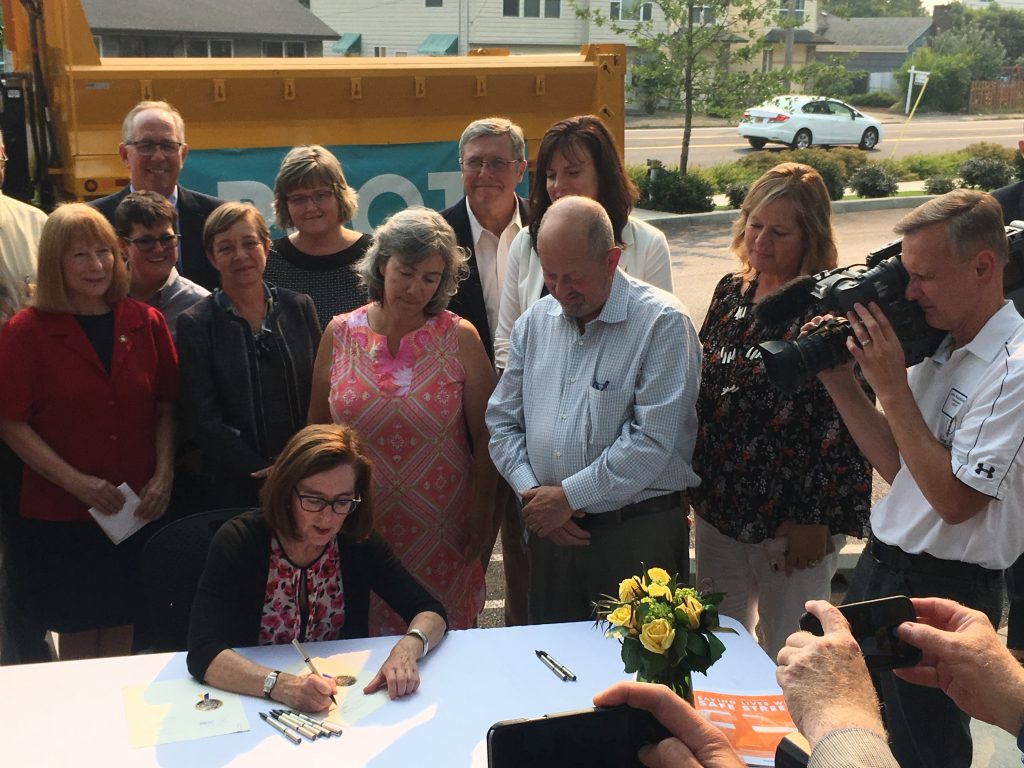
Governor Kate Brown is conducting signing ceremonies in communities throughout Oregon this week to celebrate the passage of Oregon’s transportation package. While the governor, legislature, and stakeholders are enjoying this victory lap on a big legislative effort, the hard work of implementing the bill is yet to come.
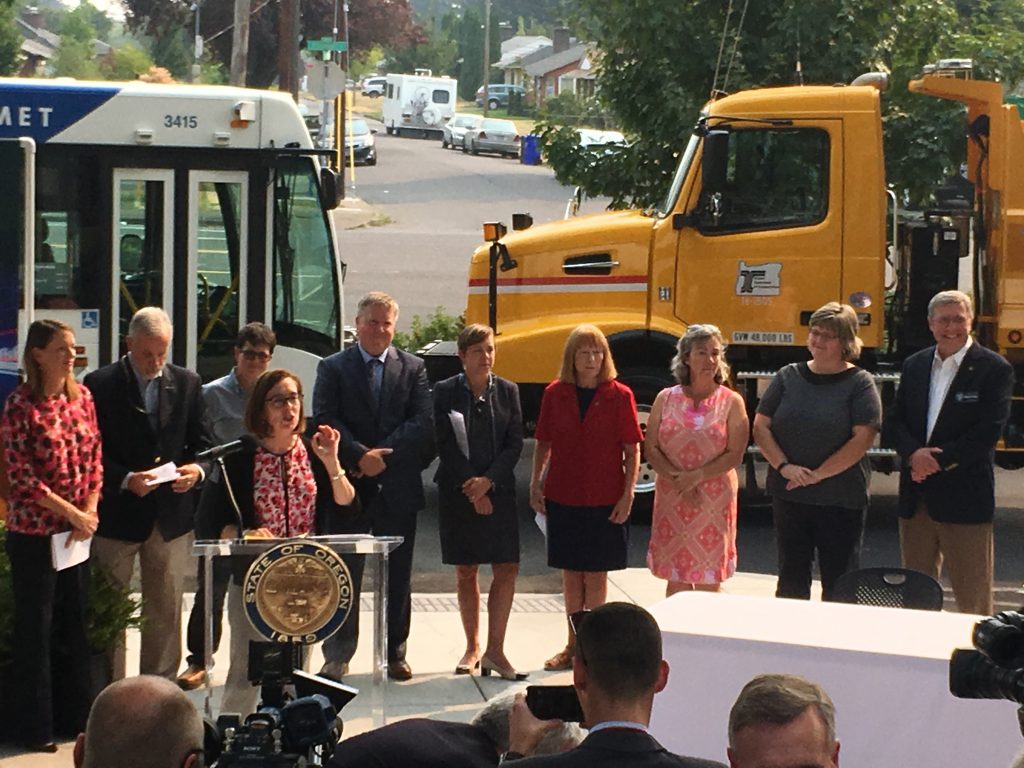
“The transportation package is truly a roadmap to Oregon’s future. Let’s keep Oregon moving forward.” Gov. Kate Brown speaking at a signing ceremony earlier this week.
HB 2017 represents a big investment in transportation for Oregon – $5.3 billion over 10 years, with over $1 billion in state dollars dedicated to transit. But there are many questions remaining about how that funding will be spent.
Over the 10-year timeframe the package dedicates almost $800 million for a variety of earmarks; however, most earmarks are not cost-specific, shifting numerous critical decisions to later dates. Instead, each region receives a determined amount of funding for multiple projects.
This lack of specificity could be a curse or a blessing. Oregon’s DOT and the Oregon Transportation Commission (OTC) could interpret the lack of specificity as flexibility to spend designated dollars more effectively, like scoping projects to maximize return on investment. But to do so, they’ll need to apply “practical solutions” effectively.
The bill more than triples state funding for public transit. This will require the OTC to develop and finalize rules in less than a year for rationally distributing over $100 million each year in new funding to a wide variety of transit agencies — urban and rural, large and small. How will the OTC and local transit agencies quickly develop a process to demonstrate accountability and transparency in distributing and using that funding effectively?
A big challenge for implementers of this bill is that it’s not big enough to address everything. While the bill includes substantial new funding for repair, many roads and bridges in the state will continue to deteriorate. The freeway bottlenecks addressed in the bill are only a small subset of those in the Portland region, and may become clogged again due to induced demand in a few years. Will the public understand the limits of the package the legislature passed, even as they see their taxes increase?
The bill requires study and possible implementation of congestion pricing on major freeways in Portland. ODOT is already hiring for new positions to tackle this challenge. Congestion pricing (also called value pricing) has the potential to address many of Oregon’s congestion challenges in a fundamental way, but that doesn’t necessarily make it any easier. While shown to be highly effective in several cases, value pricing is politically difficult and a new technical challenge for Oregon.
Passing the bill was a huge success, but that was just part of what’s needed.
If Oregon’s leaders don’t construct a strong framework for accountability and measuring performance, it’ll be like making a great pass but then kicking the ball back into their own goal. Oregon’s work on this transportation bill is far from done, and those involved in passing the bill have much work to do to deliver on its promise to Oregonians.
Stories You May Have Missed – Week of August 25th
Stories You May Have Missed
As a valued member, Transportation for America is dedicated to providing you pertinent information. This includes news articles to inform your work. Check out a list of stories you may have missed last week.
- President Trump has dropped plans to form an infrastructure council that would have advised him on the infrastructure plan his administration is putting together. (Bloomberg)
- “The Trump administration is seeking input from rural communities around the U.S. as it assembles a $1 trillion infrastructure package.” (The Hill)
- The U.S. Senators from New Jersey and New York have called on U.S. DOT to revisit their plan to withdraw a proposed regulation to test rail and truck operators for sleep apnea. (Progressive Railroading)
- Our partners, the National Complete Streets Coalition (NSCS), did a question and answer session with a board member of the National Transportation Safety Board (NTSB) on their new report documenting that 31% of all deaths on our roadways are due to speeding. The report provides recommendations on how to reduce deaths. (NCSC, Streetsblog)
- Asset Recycling an Alternative Approach to P3s. Learn more about the practice of selling or leasing existing, publicly-owned infrastructure and using the proceeds to pay for building or maintaining other infrastructure. Read T4A member summary here.
Webinar recap: What is asset recycling?

Catch up with our webinar on Asset Recycling: An Alternative Approach to P3s with the full recording of the presentation.
In light of the current administration’s intense focus on public-private partnerships (P3s), last week we discussed a specific type of P3 known as asset recycling, the practice of selling or leasing existing, publicly-owned infrastructure and using the proceeds to pay for building or maintaining other infrastructure.
Along with T4America expert Beth Osborne, Robert Puentes, President and CEO of the Eno Center for Transportation, discussed the strengths, weaknesses and potential pitfalls of this approach for transportation, and shared three specific case studies from Australia, Virginia, and Indiana.
View the full session below.
Is your organization a Transportation for America member? Transportation for America is dedicated to building strong coalitions and delivering policy wins, funding opportunities, and more to our members. Proudly supporting public entities, businesses, non-profit organizations, and universities, our members receive exclusive transportation policy information and a host of other benefits. Contact us about joining today.
T4A members can read the full summary on asset recycling here. (You may need to log in first.)
Elected officials and local organizations: Support TIGER & public transit funding
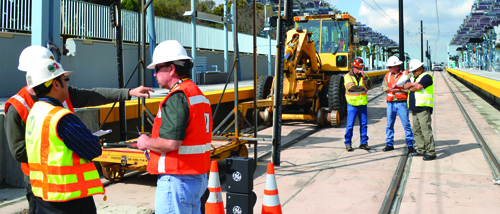
Facing the prospect of severe cuts from the Trump administration and Congress, T4America is looking for elected officials and organizations to show their support for investing in smart projects to move goods, move people and support the local economies that our nation’s prosperity is built on.
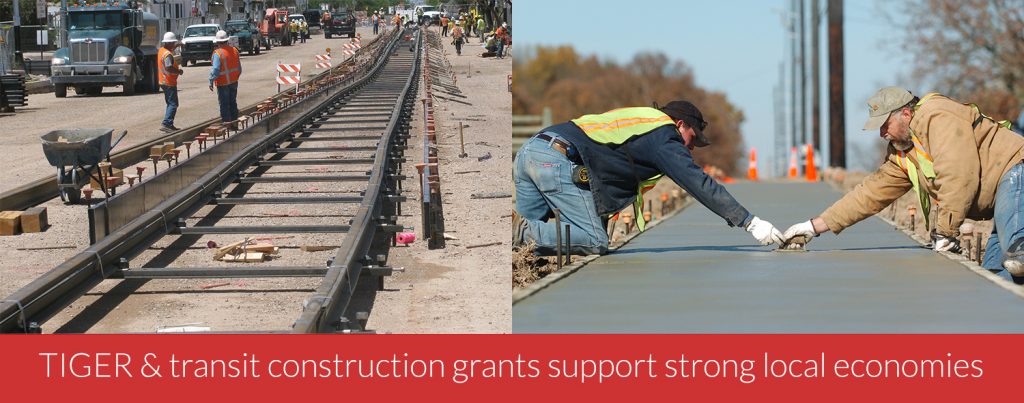
Updated 9/6/2017 9:00 a.m. — The letter is closed. We’ll publish the final letter and share the signatories soon. Thanks!
Calling all elected officials, local, civic and business leaders, and local, regional or state organizations! Sign a letter urging those currently assembling the federal transportation budget for the upcoming year (FY 2018) to prioritize funding for TIGER competitive grants, new transit construction, and passenger rail programs.
Read the full letter and sign it today — we’re aiming to deliver it before the end of August. Ed note: This letter is intended for organizations and is not open for individuals, other than elected officials at any level.
Where do we stand in the budget process?
For these three programs, this simple chart below shows four things: the current funding levels for this year, what the President proposed in his budget earlier this year, and what was recently approved by appropriations committees in the House and the Senate.
| Enacted 2017 levels | President Trump's request for 2018 | House 2018 Appropriations | Senate 2018 Appropriations | |
|---|---|---|---|---|
| TIGER Grants | $500 million | $0 | $0 | $550 million |
| Transit Capital Grants | $2.4 billion | $0 | $1.75 billion | $2.133 billion |
| Amtrak & passenger rail | $1.495 billion | $795 million (All cuts come from eliminating federal funding for all long-distance routes) | $1.4 billion | $1.6 billion |
| TOTAL THUD FUNDING | $57.65 billion | $47.4 billion | $56.5 billion | $60.058 billion |
As you can see, while committees in the Senate ignored the president’s call to eliminate TIGER and funding for new transit construction outright, those final decisions will be made by Congress as they debate the budget on the floor and then try to reconcile their different versions. (Worth noting: The House proposed eliminating TIGER funding and a barebones budget for keeping in-progress transit projects moving, which means that’s their starting point on negotiations.)
What we’re asking for is for Congress to approve a budget that fully funds the FAST Act, the current transportation authorization, already agreed to by Congress and approved by a bipartisan vote back in 2015.
More background is below:
TIGER
The majority of all federal transportation dollars are awarded to states and metro areas in a way to ensure everyone gets a share, regardless of how they’re going to spend those dollars or how well-conceived their projects are. TIGER operates differently.
The TIGER program has illustrated a productive way to use a small amount of money (about $500 million annually since 2009) to incentivize smarter projects based on their merits. This fiercely competitive program is one of the few ways that local communities of almost any size can directly receive federal dollars for their priority transportation projects. Projects vying for funding compete against each other on their merits to spend the dollars more effectively. They also bring more private, local, or state dollars to the table. Through the first seven rounds, each TIGER dollar brought in 3.5 non-federal dollars, in contrast to federal money for building new roads, for example, which only bring in about 20 state/local cents for each 80 federal cents.
Transit Capital Investment Grants
The Transit Capital Investment Grants program (often broadly referred to as New Starts) supports metro areas of all sizes that are investing their own money in building or expanding transit service.
While making the case for eliminating the program, the Trump Administration recently stated that “localities should fund these localized projects,” but local voters and leaders are doing that already, putting their own skin in the game to meet the growing demand for well-connected locations served by transit. At the ballot box last November alone, voters approved more than $200 billion dollars in tax increases to invest in these projects. But cities of all sizes are counting on the federal government to continue supporting these bottom-up efforts, as they’ve done for decades. Eliminating this program or even just reducing its funding will threaten their economic prospects and their ability to satisfy the booming demand from residents and employers alike for well-connected locations served by transit.
Passenger rail
President Trump proposed cutting Amtrak’s budget nearly in half, with nearly all cuts coming from eliminating long-distance passenger rail service. Funding for the Northeast Corridor would survive, as would the funding for state-supported routes.
But neither chamber heeded this call from the administration: the House approved slightly less funding compared to last year, while the Senate provided the full amount outlined in the FAST Act, allocating competitive funds for safety, state of good repair for the Northeast Corridor, and operating and capital support for restored or new passenger service throughout the rest of the country.
A Colorado city in the Smart Cities Collaborative partners with Uber for a “quicker way to deploy transit to our residents”
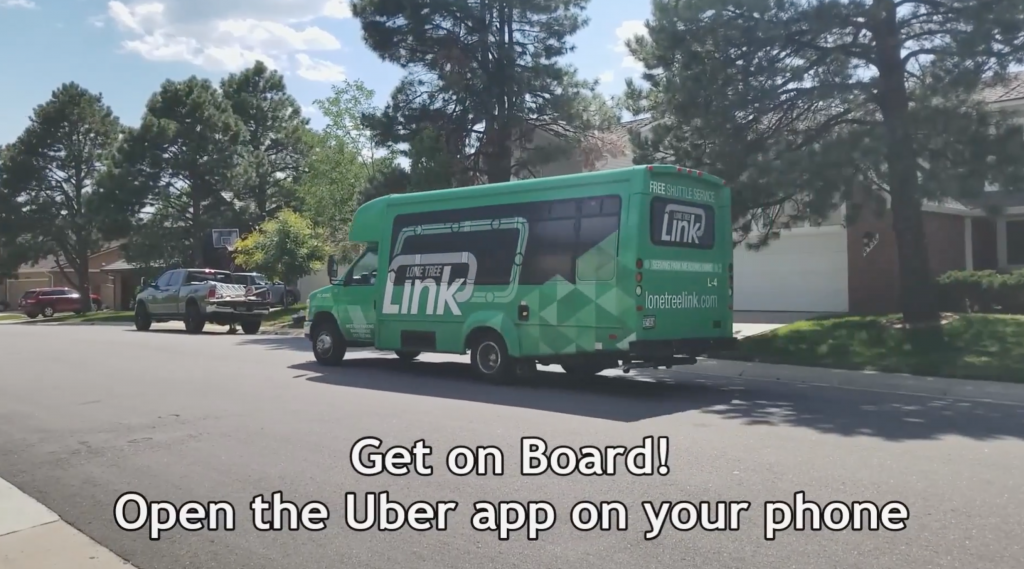
Lone Tree, Colorado, one of the 16 members of our Smart Cities Collaborative, successfully launched a new pilot project last week. The small Denver suburb is evolving their existing fixed-route circulator served by four small buses by adding an on-demand component through a partnership with Uber.
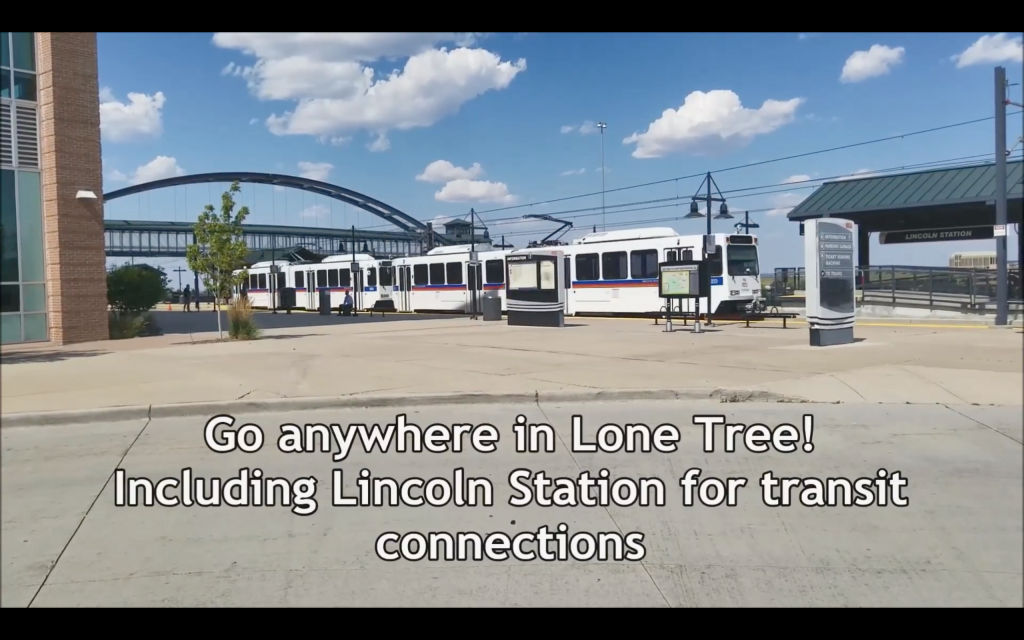
Screenshot from the Lone Tree Link’s “How to Ride” video. http://www.lonetreelink.com/link-on-demand
For nearly three years, the city of Lone Tree southeast of Denver has been operating a fixed-route shuttle line every ten minutes on a loop that connects a Denver RTD light rail station with most of the city’s major employers. The Lone Tree Link has been funded through a unique public-private partnership that includes some of those employers. This helps cover the cost and provide the rides for free to customers, but running four buses on a predictable loop and maintaining ten-minute headways also limits the reach of the service.
In an evolution for the service, last week the city launched Lone Tree Link On Demand, which pairs Uber’s technology with the city’s vehicles and drivers to expand that service to more residents and increase accessibility. Now through the end of December anyone can use the Uber app to hail a Lone Tree Link shuttle for a free ride between any two points within the City of Lone Tree.

Screenshot from the Lone Tree Link’s “How to Ride” video. http://www.lonetreelink.com/link-on-demand
“We wanted to extend the reach of the successful circulator,” Seth Hoffman, the city manager of Lone Tree, told T4America last week. For the fixed-route service, “to get the headways we wanted to achieve, we had to keep the initial route narrow in scope. But that meant that it served employers but didn’t really serve retailers or residents. Putting it on demand makes it available to every address in the city.”
The genesis of Lone Tree’s partnership with Uber came about through the Smart Cities Collaborative.
“Our inclusion in the Smart Cities Collaborative got us in the door with Uber,” said Jeff Holwell, the economic development director of Lone Tree, referring to the ‘Industry Day’ portion of the Collaborative. “That connected us with Uber’s Denver office, which is what made this happen.”
“We were really floundering before that meeting,” Hoffman told us, but the connection with Uber at the Collaborative meeting helped them clear the final hurdle.
“Early on, we thought we’d find someone to help us develop our own app and start from scratch. But what we realized based on others’ experiences in the Collaborative, and through our contacts with T4A, was that smartphone real estate is really hard to compete with. If we could find someone that’s doing it and doing it well, that’s a quick path to our pilot.”
This partnership with Uber — which is as much a pilot for the private company as it is for the city — has simplified some of those tech issues. For example, as Holwell noted, adding one of the city’s extra shuttles to the service is “so easy with Uber’s technology — [the service] is as scalable as Uber is and they have incredible technology that we don’t have to create or update.”
The Denver Post covered the launch last week, and included a story that illustrates how the expanded service allows the city to connect residents and visitors to even more destinations in the city of about 10,000 people:
Divya Sheshathri and her friend Mugdha Maneesh used the service on Tuesday to get from Sheshathri’s home on Park Meadows Drive to her husband’s office on the Charles Schwab campus. They used it again to get from Schwab to Park Meadows mall for afternoon shopping. “It’s a very good service,” said Sheshathri, who does not own a car. “Without this it would be very hard to get around. We’re comfortable walking, but not in this hot sun.”
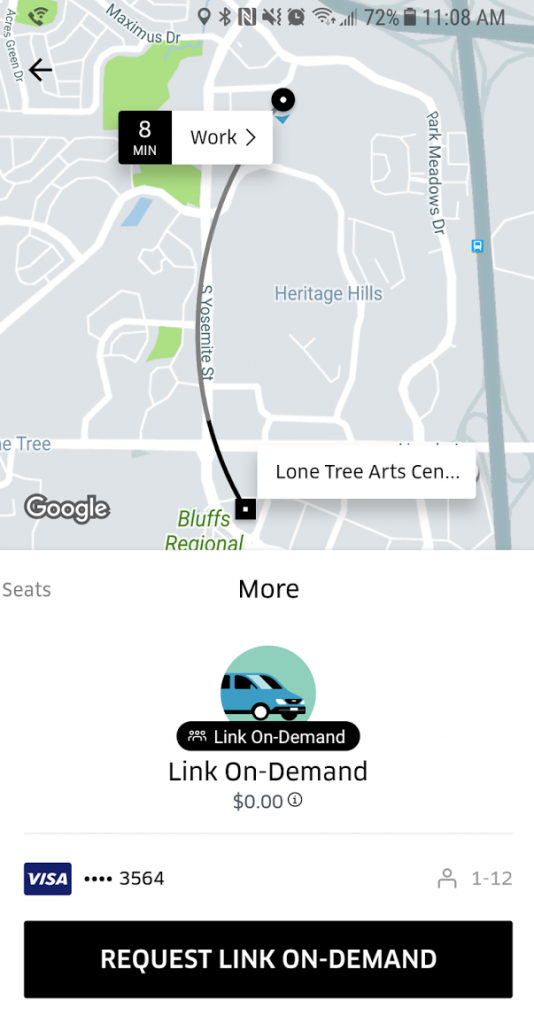 For the pilot, Holwell said that they removed one of the four buses from the fixed route and reassigned it to the on-demand service, allowing the city to better calibrate their service with the need. And the returns have been positive thus far.
For the pilot, Holwell said that they removed one of the four buses from the fixed route and reassigned it to the on-demand service, allowing the city to better calibrate their service with the need. And the returns have been positive thus far.
“There was an immediate effect on day one,” Holwell said. “We’re already getting more ridership on that one vehicle than it was providing on the fixed route.”
While operating the fixed-route service is still their “bread and butter,” according to Holwell, with an additional RTD light rail station slated to open in 2019 just to the south that will replicate a portion of the fixed route service, shifting all of their resources to an on-demand service could be the roadmap for the future.
“We only operate during weekdays during office hours because it doesn’t make sense to run on weekends through empty office parks,” Holwell said. And even then, the fixed-route Link shuttles are obviously more heavily used at certain times like the start and end of the workday, leaving excess capacity during the day while they carry fewer passengers. With an entirely on-demand service, the city could better utilize their capacity and reduce empty miles traveled, which is one of their broader goals for the new on-demand service.
Lone Tree’s leaders are proactively using technology to become the kind of place they want to be long-term. And finding ways to better utilize their existing resources to serve residents, visitors and employers — whether transit vehicles or roadway space — is what this project is all about.
“Our big picture goal is to leverage the assets that we already have,” Hoffman said. “We can’t build additional lanes to fit more cars, so we’re going to try to use the lanes we have more efficiently. People are taking it to restaurants and taking it shopping, which helps out the local economy. As a medium dense suburban community, the density isn’t there in a way that would make a [larger] fixed route system work efficiently. This is a quicker way to deploy transit to our residents.”
Stories You May Have Missed – Week of August 18th
Stories You May Have Missed
As a valued member, Transportation for America is dedicated to providing you pertinent information. This includes news articles to inform your work. Check out a list of stories you may have missed last week.
- Driving Community Change, The National Urban League and Lyft Inc. are joining forces to advance ride-hailing services for every community, especially those that are underserved. (Morning Consult)
- Traffic deaths down slightly, but still historically high. Traffic deaths have declined slightly this year but are still higher than two years ago, according to preliminary estimates.(The Hill)
- Public forum will explore TOD in Chicago. (Curbed Chicago)
Stories You May Have Missed – Week of August 10th
Stories You May Have Missed
As a valued member, Transportation for America is dedicated to providing you pertinent information. This includes news articles to inform your work. Check out a list of stories you may have missed last week.
- President “Trump says he may not work with Dems on infrastructure” but still expects bipartisan support for any plan his administration proposes. (The Hill)
- “Self-driving cars could transform jobs held by 1 in 9 U.S. workers” (Marketwatch)
- “Salt Lake City seeks major transit improvements, but money could be a roadblock.” (Salt Lake Tribune)
- New York Governor Andrew Cuomo says that New York will actively consider congestion pricing in New York City. (NY Times)
- The Washington Post looks at the transit renaissance going on in Los Angeles (Washington Post)
An exciting time for bus rapid transit
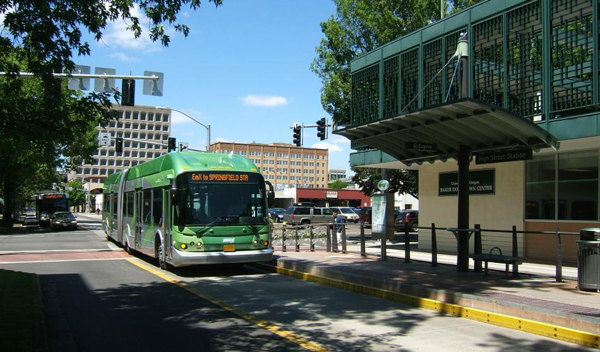

A new study found that BRT in Eugene, OR had a positive impact on the livability of the surrounding communities. (Photo credit: Lane Transit District)
Investments in high-capacity public transit such as light rail and subways continue to demonstrate their ability to substantially increase property values along transit alignments. But can we say the same about buses?
Interest in bus rapid transit (BRT) is booming across the country as an effective and more affordable transit investment. Yet little research has been completed on their economic impacts in the U.S., partially because only a limited number of BRT projects have been completed here. Elected officials, real estate developers, and other key decision-makers are eager for more information on whether investments in BRT will pay off in their own communities.
The National Institute for Transportation and Communities (NITC), in partnership with Transportation for America, released an early study last year that found that BRT can indeed generate economic development, attract jobs, retails, and affordable housing.
Building on that research, NITC recently published a new study that takes a closer look at the impact of one specific BRT system. Researchers examined the Emerald Express (EmX) — a BRT system that connects downtown Eugene to Springfield, Oregon — and found that the EmX line improved the livability of the surrounding communities:
“The EmX line had a statistically significant positive impact on property values, which stands to benefit the community as a whole: the related taxes can be used to pay for transportation and other infrastructure, further enhancing the economic development of the community.”
This is an exciting time for BRT in the U.S. — BRT projects are currently underway in dozens of cities, several of which are taking part in the FTA TOD Technical Assistance Initiative. Visit the TODresources.org hub to access a trove of research on how to maximize the development potential of BRT corridors.
Recent TOD news
Here are a few things that have been happening this week with TOD projects across the country.
- Development ramps up near Meriden CT station – Connecticut Mirror
- Development opportunities near transit lost in Bay Area downzonings – San Francisco Business Times
- Boston project emphasizes needs for more travel options – Boston Globe
- The density frequency guarantee – The Urbanist
- St. Paul proceeds with Ford site redevelopment despite opposition – Minneapolis Star Tribune
(Cross-posted from TODresources.org)
Stories You May Have Missed – Week of August 4th
Stories You May Have Missed
As a valued member, Transportation for America is dedicated to providing you pertinent information. This includes news articles to inform your work. Check out a list of stories you may have missed last week.
- “Infrastructure borrowing drops as U.S. states await” details on President Trump’s infrastructure plan. (Reuters)
- Amid growing frustration with the lack of details from the Trump administration about their infrastructure plan, Congressional committees are moving ahead gathering input and drafting their own plans. (The Hill)
- The Atlantic Magazine dives into why Congressional Republicans are having trouble passing a Fiscal-Year 2018 budget resolution and what it means for their legislative agenda, including tax reform. (The Atlantic)
- The Federal Rail Administration and the Federal Motor Carrier Safety Administration have withdrawn a proposed regulation from the Obama administration that would have required railroad and truck companies to test employees for sleep apnea. (USA Today)
- Senators from New York and New Jersey have prevented confirmation of certain U.S. DOT nominees because of a dispute with U.S. DOT on the amount of federal involvement in the Gateway project that would build a new rail tunnel under the Hudson River between New Jersey and New York City. (Cetus/Wall Street Journal)
- U.S. DOT has announced the winners $79 million in FASTLANE/INFRA grant awards for small projects. Awards for large projects under FASTLANE/INFRA have been delayed until the fall and U.S. DOT is requiring entities seeking awards for large projects to resubmit their application. (Progressive Railroading)
Summary of FY2018 Senate Transportation, Housing and Urban Development “THUD” Appropriations Bill
On Thursday July 27, the U.S. Senate Committee on Appropriations approved the fiscal year 2018 Transportation, Housing and Urban Development, and Related Agencies Appropriations bill.
The U.S. Department of Transportation is funded at $19.47 billion for fiscal year (FY) 2018. This is $978 million above the FY2017 enacted level. The Committee’s priority is placed on programs that improve the safety, reliability, and efficiency of the transportation system.
The Senate Appropriations Committee proposes to increase funding for the Transportation Investment Generating Economic Recovery (TIGER) grant program after the President and the House Appropriations Committee proposed to eliminate it. Instead, the bill increases funding to $550 million – $50 million more than the FY 2017 funding level. The bill also reserves 30 percent of the awards for rural areas.
Senate Appropriations Chairman Susan M. Collins in her opening statement at the markup highlighted that TIGER is a proven program that funds competitive grants for state and local road, transit, port, and railroad construction projects. “Last year, 585 applicants from all 50 states and territories requested nearly $9.3 billion in assistance, demonstrating the need for and popularity of this program. Only 40 of these applications could be funded,” said Chairman Collins.
The committee expressed strong support for the TIGER program in the report that accompanies the appropriations bill and required the Trump Administration to apply the criteria used in FY2016 to the FY2018 round of TIGER.
The Senate bill allocates a total of $2.133 billion for the transit Capital Investment Grant (CIG) Program, which is $279.7 million less than the FY 2017 enacted level and $900.9 million more than the President’s budget request. Of the $2.133 billion, 1.008 billion is set aside for New Starts projects that already have full funding grant agreements (FFGAs), and $454 million is reserved for new New Starts FFGAs. Additionally, $149.9 million is reserved to complete funding for previously funded Small Starts projects that do not have signed agreements, and $168.4 million is reserved for new Small Starts projects. Finally, $200 million is set aside to cover the cost of the two existing Core Capacity projects, and $145.7 million is reserved for new Core Capacity FFGAs.
The Senate Bill includes language directing the USDOT Secretary to “continue to administer the Capital Investment Grant Program in accordance with the procedural and substantive requirements of” the law, including directing the “Secretary to continue to advance eligible projects into project development and engineering in the capital investment grant evaluation.” Basically, when CIG projects become eligible to move along in the pipeline, this language requires the Secretary to advance them. The Committee included this language in response to the Administration’s budget proposal that stated it would only fund transit projects with an existing FFGA.
The appropriations bill also fully funds the highway, transit, and safety programs authorized by the FAST Act and funded through the Highway Trust Fund. The bill includes $45 billion for the Federal-aid Highways Program. In addition, the bill continues to grant State Departments of Transportation permission to repurpose old, unused earmarks for important infrastructure projects.
The Federal Railroad Administration (FRA) is funded at $1.97 billion, $122 million above the FY 2017 enacted level. The bill provisions include $358.4 million for Amtrak’s Northeast Corridor and $1.242 billion for Amtrak’s National Network, which is enough funding to continue service for all current routes. The bill also provides $250.1 million to fund FRA’s safety, operations, research and development activities. The Consolidated Rail Infrastructure and Safety Improvement Grants Program is funded at $92.5 million, of which $35.5 million is for initiation or restoration of passenger rail. The Federal-State Partnership for State of Good Repair Grants program is funded at $26 million and the Restoration and Enhancement Grants program is funded at $5 million.
Additionally, the committee made a major statement to the administration about policy in its appropriations report (page 8 and 9) and the importance of stable and robust transportation funding.
“The President’s request includes $200,000,000,000 to leverage $1,000,000,000,000 in new investment in the Nation’s physical infrastructure. This proposal is expected to include policy, regulatory, and legislative proposals, ranging from changes to existing programs, to the creation of new programs and initiatives to reshape how the Federal government invests, permits, and collaborates on infrastructure. To date, no such proposal has been submitted to the Committee. While the Committee fully supports additional spending for our Nation’s infrastructure, it strongly disagrees with the Administration’s assertion that providing Federal dollars for infrastructure has created, ‘an unhealthy dynamic in which State and local governments delay projects in the hope of receiving Federal funds.’”
“Without Federal investment in infrastructure, particularly in our nation’s highway network and transit systems, the ability to move freight across the country and the free movement of people between States with vastly differing abilities to fund infrastructure would be compromised. The Committee is also concerned that the Administration does not realize that State and local governments, through the statewide transportation improvement program planning process, already determine the “right level–and type–of infrastructure investment needed for their communities.” More troubling is the fact that the budget request assumes that after fiscal year 2020, highway trust fund outlays will be at levels that are supported with existing tax receipts, resulting in an outlay reduction of $95,000,000,000 over fiscal years 2021-2027. The Administration’s approach is dangerously close to support for devolution of Federal funding provided by the Highway Trust Fund, an idea the Committee strongly opposes.”
Overall, the bill protects funding for the programs that T4America believes are crucial to our transportation system like TIGER and the Capital Investment Grant Program. This bill is a great step to ensure that key infrastructure and transit programs will be funded accordingly, and will continue to serve the nations most vulnerable persons.
T4America and LA CoMotion partner for a week-long discussion on urban mobility challenges and solutions
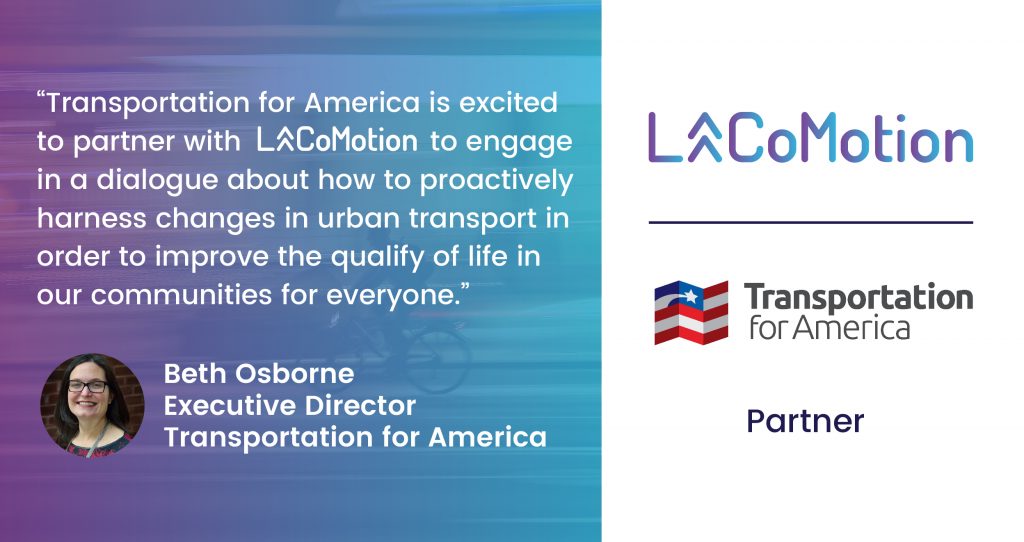
Transportation for America is delighted to partner with LA CoMotion, a unique five-day event bringing together the global leaders of the urban mobility revolution this November.

The first edition of LA CoMotion takes place in Downtown Los Angeles’ vibrant Arts District from November 15th through 19th, 2017. The immersive event features cutting-edge discussions, demos, test drives and exhibitions – an exciting glimpse into our urban future.
John Rossant, Founder and Chief Curator of LA CoMotion said:
“The urban mobility revolution is set to transform every city in the world. Robust urban transport is indispensable to making cities more inclusive, connected, healthy and vibrant. LA CoMotion is pleased to partner with Transportation for America, an alliance of community leaders working to build stronger economies through better transportation networks. We look forward to working with T4America to deploy mobility solutions for all communities, large and small.”
LA CoMotion will also dovetail with the next meeting of our Smart Cities Collaborative, which we’ll be hosting in Downtown Los Angeles, November 14th and 15th.
This meeting will close out the first year of our Collaborative. As they have throughout the past year, participant cities will collaborate to develop policies and projects enabling them to test and pilot automated vehicles, shared mobility and other emerging technologies. Additionally, cities will explore innovative procurement and contracting models, how best to partner with private mobility and data providers, and will work together to create state level policy frameworks in preparation for the upcoming 2018 legislative sessions across the country.
We’re looking forward to our partnership with LA CoMotion and to an inspiring week of dynamic conversations around the future of smart mobility this November.
Friends and members of Transportation for America can request a special discount code for LA CoMotion here.





